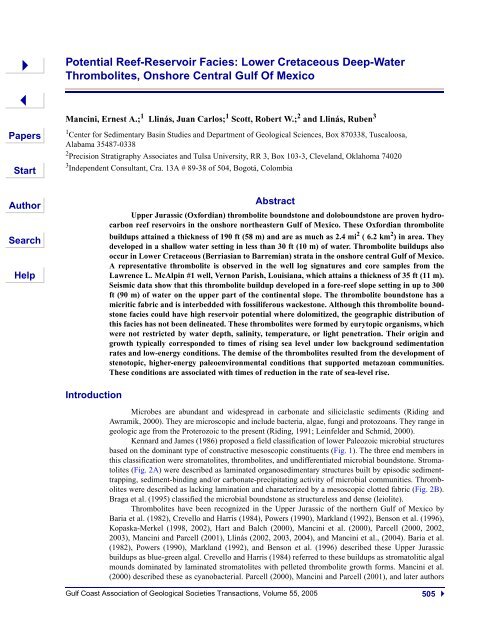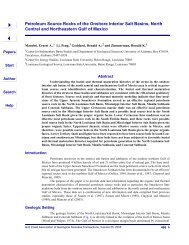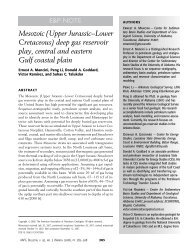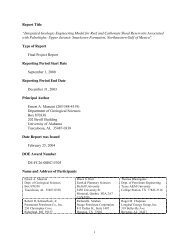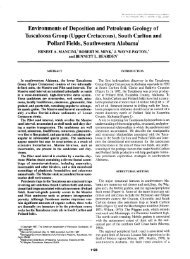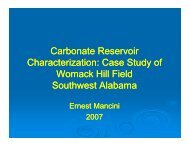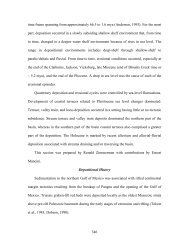Potential Reef-Reservoir Facies: Lower Cretaceous Deep-Water ...
Potential Reef-Reservoir Facies: Lower Cretaceous Deep-Water ...
Potential Reef-Reservoir Facies: Lower Cretaceous Deep-Water ...
Create successful ePaper yourself
Turn your PDF publications into a flip-book with our unique Google optimized e-Paper software.
<strong>Potential</strong> <strong>Reef</strong>-<strong>Reservoir</strong> <strong>Facies</strong>: <strong>Lower</strong> <strong>Cretaceous</strong> <strong>Deep</strong>-<strong>Water</strong>Thrombolites, Onshore Central Gulf Of MexicoMancini, Ernest A.; 1 Llinás, Juan Carlos; 1 Scott, Robert W.; 2 and Llinás, Ruben 31 Center for Sedimentary Basin Studies and Department of Geological Sciences, Box 870338, Tuscaloosa,Alabama 35487-03382 Precision Stratigraphy Associates and Tulsa University, RR 3, Box 103-3, Cleveland, Oklahoma 740203 Independent Consultant, Cra. 13A # 89-38 of 504, Bogotá, ColombiaIntroductionAbstractUpper Jurassic (Oxfordian) thrombolite boundstone and doloboundstone are proven hydrocarbonreef reservoirs in the onshore northeastern Gulf of Mexico. These Oxfordian thrombolitebuildups attained a thickness of 190 ft (58 m) and are as much as 2.4 mi 2 ( 6.2 km 2 ) in area. Theydeveloped in a shallow water setting in less than 30 ft (10 m) of water. Thrombolite buildups alsooccur in <strong>Lower</strong> <strong>Cretaceous</strong> (Berriasian to Barremian) strata in the onshore central Gulf of Mexico.A representative thrombolite is observed in the well log signatures and core samples from theLawrence L. McAlpin #1 well, Vernon Parish, Louisiana, which attains a thickness of 35 ft (11 m).Seismic data show that this thrombolite buildup developed in a fore-reef slope setting in up to 300ft (90 m) of water on the upper part of the continental slope. The thrombolite boundstone has amicritic fabric and is interbedded with fossiliferous wackestone. Although this thrombolite boundstonefacies could have high reservoir potential where dolomitized, the geographic distribution ofthis facies has not been delineated. These thrombolites were formed by eurytopic organisms, whichwere not restricted by water depth, salinity, temperature, or light penetration. Their origin andgrowth typically corresponded to times of rising sea level under low background sedimentationrates and low-energy conditions. The demise of the thrombolites resulted from the development ofstenotopic, higher-energy paleoenvironmental conditions that supported metazoan communities.These conditions are associated with times of reduction in the rate of sea-level rise.Microbes are abundant and widespread in carbonate and siliciclastic sediments (Riding andAwramik, 2000). They are microscopic and include bacteria, algae, fungi and protozoans. They range ingeologic age from the Proterozoic to the present (Riding, 1991; Leinfelder and Schmid, 2000).Kennard and James (1986) proposed a field classification of lower Paleozoic microbial structuresbased on the dominant type of constructive mesoscopic constituents (Fig. 1). The three end members inthis classification were stromatolites, thrombolites, and undifferentiated microbial boundstone. Stromatolites(Fig. 2A) were described as laminated organosedimentary structures built by episodic sedimenttrapping,sediment-binding and/or carbonate-precipitating activity of microbial communities. Thromboliteswere described as lacking lamination and characterized by a mesoscopic clotted fabric (Fig. 2B).Braga et al. (1995) classified the microbial boundstone as structureless and dense (leiolite).Thrombolites have been recognized in the Upper Jurassic of the northern Gulf of Mexico byBaria et al. (1982), Crevello and Harris (1984), Powers (1990), Markland (1992), Benson et al. (1996),Kopaska-Merkel (1998, 2002), Hart and Balch (2000), Mancini et al. (2000), Parcell (2000, 2002,2003), Mancini and Parcell (2001), Llinás (2002, 2003, 2004), and Mancini et al., (2004). Baria et al.(1982), Powers (1990), Markland (1992), and Benson et al. (1996) described these Upper Jurassicbuildups as blue-green algal. Crevello and Harris (1984) referred to these buildups as stromatolitic algalmounds dominated by laminated stromatolites with pelleted thrombolite growth forms. Mancini et al.(2000) described these as cyanobacterial. Parcell (2000), Mancini and Parcell (2001), and later authorsGulf Coast Association of Geological Societies Transactions, Volume 55, 2005505
<strong>Potential</strong> <strong>Reef</strong>-<strong>Reservoir</strong> <strong>Facies</strong>: <strong>Lower</strong> <strong>Cretaceous</strong> <strong>Deep</strong>-<strong>Water</strong> Thrombolites, Onshore Central Gulf Of MexicoThrombolites(clotted)Figure 1. Microbial textures: Classificationof microbial textures is based onthe dominant type of constructive mesoscopicconstituents proposed by Kennardand James (1986) and Braga et al.(1995).Stromatolites(laminated)Leiolites(dense)Figure 2. Core photographs of microbial textures: (A) stromatolite found in Vocation Field, MonroeCounty, Alabama, well Permit #3739 at a depth of 14,066 ft (4,287 m), and (B) thrombolitebuildup in Little Cedar Creek Field, Conecuh County, well Permit #13472 at a depth of 11,553 ft(3,521 m).referred to these buildups as thrombolitic. <strong>Lower</strong> <strong>Cretaceous</strong> thrombolite mounds are well developedboth on the platform margins and on the upper slope in northern Spain (García-Mondéjar and Fernández-Mendiola,1995).The purpose of this paper is to characterize <strong>Lower</strong> <strong>Cretaceous</strong> (Berriasian to Barremian) pre-Sligo (Hosston) thrombolite buildups from the subsurface of west-central Louisiana. These buildupswere observed in core from the Lawrence McAlpin #1 well, Vernon Parish, Louisiana (Fig. 3A).506
Mancini et al.(A)(B)SLAWRENCE L. McALPIN1NUpper K.AlbianAptianLawrence L.McAlpin #1Aptian Shelf MarginTBILouisianaSEISCOM DELTA LINETIME SECTIONVernon & Sabine Parishes,LouisianaAmoco Production Co.0 4 Mi0 4 KmFigure 3. Lawrence L. McAlpin #1 well , Vernon Parish, Louisiana, (A) Location map including the position ofthe Aptian shelf margin, and (B) South-North migrated seismic section with the location of the McAlpin welland illustrating the Upper <strong>Cretaceous</strong>, Albian, and Aptian shelf margins. Notice the progradation of the pre-Aptian shelf margin expressed by high amplitude south-dipping reflectors (modified from Tyrrell and Scott,1987). TBI = <strong>Lower</strong> <strong>Cretaceous</strong> thrombolite buildup interval.Thrombolite CharacterizationThe thrombolite in the McAlpin #1 well was identified in the lithologic core. The suite of logsavailable for this well consisted of spontaneous potential (SP) and resistivity (ILD) curves (Fig. 4). Nodistinctive pattern was recognized in these curves as indicative of the presence of the thrombolite. However,there is an interval of approximately 80 ft (24 m) thick, containing the thrombolite buildup and thebeds directly above it, which shows relatively low SP values coupled with high resistivity readings.Above the cored interval, a thick section characterized by low SP values in conjunction with high resistivities,suggests the presence of massive limestone beds. Below the cored interval, the SP curve has asteady pattern in the high range, while the ILD curve shifts toward lower readings indicating a predominantlyshaley section.The cored section that includes the thrombolites is 200 ft (61 m) (Fig. 4) and consists largely ofdark gray bioturbated wackestone and mudstone characterized by concoidal fractures. Some thin oncoidalpackstone beds are also present. The microbial buildup attains a total thickness of 35 ft (11 m) andconsists of dark gray thrombolite boundstone interbedded with moderately gray wackestone. Thethrombolite buildup shows the characteristic clotted fabric formed by microbial colonies and finelycrystalline carbonate sediment (Figs. 5A, C, and D). A thin breccia (Fig. 5B) is interbedded with thecalci-microbial deposit. The breccia is formed by irregular and angular wackestone fragments floatingin fine grained dark gray micritic matrix rich in fossil fragments. Much of the cored section is moderatelybioturbated; Thalassinoides and Planolites burrows are quite common. Wispy organic-richlaminae and microstylolites are also present. In thin section, the microbial framework consists of apeloidal texture with diverse types of arrangements (Fig. 6). Very fine calcite crystals (microsparite) fillthe space between the dark peloidal clusters. No open pore spaces were observed. Sparse fossil fragmentsof echinoids, bivalves, including pycnodont oysters, microsolenid corals, stromatoporoids,sponge debris, ostracods, and benthic foraminifera, including miliolids, lenticulinids, trocholinids, anduniserial and biserial foraminifera forms. Thin section analysis reveals a small amount of silt-size terrigenousgrains (1-3%), which is concentrated in burrows and other interstices and secondary quartzcrystals in matrix and fossils.507
<strong>Potential</strong> <strong>Reef</strong>-<strong>Reservoir</strong> <strong>Facies</strong>: <strong>Lower</strong> <strong>Cretaceous</strong> <strong>Deep</strong>-<strong>Water</strong> Thrombolites, Onshore Central Gulf Of MexicoMeasuredDepth(ft)LAWRENCE L.Mc ALPIN #1SP ILD-50 mV 60 3OHMM 300EXPLANATION12500NoduleEchinoids13000OncoidMicrostylolitesBioturbationPlanolitesThalassinoidesStromatoporoidsOysterBioclasts &indeterminedshellsLimestone13500SP spontaneous potentialILD Long Induction Resistivity14000feetDEPTHmetersms ws psgs bsSTRATIG.UNITDESCRIPTION14500175505350Dark gray homogeneous wackestone, rare wispylamination, few fractures.15000155001600016500170001757517600176251765017675177001772553605370538053905400Pre-Sligo (Hosston Formation equivalent)Lime mudstone grading upward to wackestone.Dark gray lime mudstone, closely spaced concoidalfractures.Moderate to dark gray, homogeneous wackestone interbeddedwith oncoidal packstone.Moderate to dark gray homogeneous wackestone, localpatches of replacement calcite.Horizontal and long vertical fractures.Gray, homogeneous wackestone, stromatoporoidsencrusting indeterminate nodular spar colonies.Dark gray thrombolite boundstone with mottled fabricof dark gray irregular hemispherical mud and interareas(cavities) of gray argillaceous lime mudstone , wackestoneinterbedded.Moderate gray homogeneous wackestone.17500177505410180001850019050DEPTHfeet meters17950 547017975180001802554805490ms ws ps gs bsFigure 4. Core description and wireline log for the Lawrence L. McAlpin # 1 well, Louisiana.STRATIG.UNITPre-Sligo (Tamaulipas Fm.)DESCRIPTIONDark gray mudstone to wackestone, fractures forming2-10 cm disks, Thalassinoides, sparse horizontal fractures.Lime mudstone grading downward to dark graycalcareous shale, fractures forming disks.Horizontal fractures increasing in abundance.Moderate to dark gray, calcareous shale with concoidalfracture, abundant horizontal fractures.Moderate to dark gray, calcareous shale with concoidalfracture, abundant horizontal fractures.508
Mancini et al.(A)f(B)(C)(D)Figure 5. Core photographs of the thrombolite interval in the Lawrence L. McAlpin #1 well: (A)17,693 ft (5,393 m), thrombolitic structure with fragments of stromatoporoids and caprinid shells,(B) 17,697 ft (5,394 m), interbedded brecciated layer formed by irregular wackestone fragmentsembedded in a micritic matrix rich in fossil debris, (C) 17,709 ft (5,398 m), non-porous thrombolitewith the characteristic clotted texture. (Notice that the lighter colored areas correspond tofine sediment precipitated among the microbial colonies that are expressed by darker colors), and(D) 17,710 ft (5,398 m), highly, bioturbated thrombolite. (Notice the lack of porosity in the samples).509
<strong>Potential</strong> <strong>Reef</strong>-<strong>Reservoir</strong> <strong>Facies</strong>: <strong>Lower</strong> <strong>Cretaceous</strong> <strong>Deep</strong>-<strong>Water</strong> Thrombolites, Onshore Central Gulf Of Mexico(A)(B)(C)(D)(E)(F)Figure 6. Photomicrographs of thrombolitic textures found in the pre-Sligo section of theLawrence L. McAlpin #1 well: (A) 17,693 ft (5,393 m), peloidal clusters (dark brown) andmicrosparite crystals, (B) 17,697 ft (5,394 m), peloidal clusters are widely separated, (C) 17,710 ft(5,398 m), peloidal clusters are less defined, (D) 17,710 ft (5,398 m), peloidal clusters with individualpeloids, (E) 17,709 ft (5,398 m), terrigenous silt-size grains within the peloidal clusters, and(F) 17,709 ft (5,398 m), peloidal clusters amalgamated and individual peloids (Notice the lack ofporosity in the examples).At a burial depth of 17,700 ft (5,395 m) and with a thickness of 35 ft (11 m), the thrombolitebuildup is not seismically resolvable. However, the seismic interval containing the microbial buildup ischaracterized by a change in seismic pattern. Moderately continuous, south-dipping clinoform reflectorsalternating between high and low amplitudes reflect a progradational shelf margin (Fig. 3B). In contrast,the shallow shelf seismic facies above the slope buildup facies are horizontal, discontinuous, with moderateamplitudes suggesting a lithologic variation of thick massive limestone beds. Based on seismicdata, the thrombolite buildup developed in a fore-reef setting. The breccias described above (Fig. 5B)510
DiscussionMancini et al.might be the result of slumps triggered by gravity, which is a common occurrence in this unstable depositionalsetting.Tyrrell and Scott (1987) reported Nannoconus steinmanni at a depth of 17,550 (5,351 m) ft in thecore. This calcareous nannoplankton species ranges in age from Berriasian to Barremian, which indicatesthat the thrombolite found in the McAlpin #1 well is age-equivalent to the Hosston Formation.The Upper Jurassic Smackover thrombolite buildups described from the eastern Gulf CoastalPlain developed in shallow water environments (below wave base in settings of less than 30 ft (10 m) inwater depth (Mancini et al., 2004). These Upper Jurassic buildups attained a thickness of 190 ft (58 m)and are as much as 2.4 mi 2 (6.2 km 2 ) in area. Based on seismic data, the <strong>Lower</strong> <strong>Cretaceous</strong> thrombolitesdescribed from the McAlpin well developed in deeper water (300 ft or 90 m), less oxygenated, fore-reefslope setting (Fig. 7). In Western Europe, Upper Jurassic bioherms of pure thrombolite occur in normalmarine settings of greater than 230 ft (70 m) and as deep as 1,300 ft (400 m) (Leinfelder and Schmid,2000; Leinfelder, 2001) (Fig. 7). Therefore, bathymetry is not a limiting factor for thrombolite growth.However, key factors for thrombolite development have been reported to include depositional conditionsinherent to a period of overall rise in sea level and lower energy settings, characterized by a hardsubstrate for nucleation, zero to low background sedimentation for initial growth, and low to moderatesedimentation rate for continued growth to support the calcification process (Leinfelder, 1993). Also,important is a paleoenvironment typified by eurytopic environmental conditions, such as fluctuations insalinity, temperature, oxygen content and/or nutrient supply that limit the growth of other reefal organisms(Mancini et al., 2004). Based on the well log and seismic data, the <strong>Lower</strong> <strong>Cretaceous</strong> thrombolitesare interpreted as being deposited during a transgressive pulse within an overall progradational carbonateshelf margin consisting largely of shale and lime mudstone. Variations in the environmental conditions,including an overall shallowing upward, which provided improved oxygen contents and higherenergy levels, contributed toward the demise of the <strong>Lower</strong> <strong>Cretaceous</strong> thrombolite buildups and theaccumulation of a thick interval of massive, shallower water limestone.intertidalmicrobial matsSmackoverstromatolite mats(GOM)lagoonal microbialoncoidsSmackover microbialoncoids (GOM)Smackover thrombolitebuildups (GOM)10 m (~30 ft)Smackover microbiallaminites (GOM)coral-thrombolitereefthrombolite reef pinnacles(Spain)50 m (~160 ft)sponge-microbolitemud mound70 m (~230 ft)90 m (~300 ft)<strong>Lower</strong> <strong>Cretaceous</strong> thrombolitein McAlpin #1 (GOM)sea leveldeeper water microbolitemud mound- O 2400 m (~1,300 ft)aphotic microbolitemud moundFigure 7. Profile of a carbonate shelf margin illustrating the paleogeographic location of thrombolite buildupsin the Upper Jurassic Smackover Formation in the northeastern Gulf of Mexico, in the Upper Jurassic stratain Spain, and in the <strong>Lower</strong> <strong>Cretaceous</strong> strata in the Lawrence L. Mc Alpin #1 well (modified from Leinfelder,1993, Leinfelder and Schmid, 2000, Mancini et al., 2004).Exploration StrategiesIn the eastern Gulf Coastal Plain, the exploration strategy for drilling a successful wildcat well inthe Upper Jurassic thrombolite reservoir play is to identify and delineate paleohighs (generally basementstructures) associated with thrombolite buildups. Although the primary control on reservoirarchitecture and geographic distribution of these reservoirs is the fabric and texture of the depositionalfacies, diagenesis (chiefly dolomitization and/or leaching) is a critical factor that enhances and createsreservoir quality. Porosity in these boundstone reservoirs is mostly secondary dolomite intercrystalline511
<strong>Potential</strong> <strong>Reef</strong>-<strong>Reservoir</strong> <strong>Facies</strong>: <strong>Lower</strong> <strong>Cretaceous</strong> <strong>Deep</strong>-<strong>Water</strong> Thrombolites, Onshore Central Gulf Of Mexicoand vuggy porosity that overprints primary shelter and fenestral porosity. The lithology of the high qualityreservoirs is thrombolite doloboundstone and leached thrombolite boundstone.The <strong>Lower</strong> <strong>Cretaceous</strong> thrombolites encountered in the McAlpin core do not overlie basementrocks, but rather these thrombolites probably grew on a localized winnowed surface. Such deeper waterthrombolite development is not unusual. The deeper water thrombolites observed in outcrop in WesternEurope formed pinnacles (Figs. 8A and B) with a height of as much as 52 ft (16 m) that nucleated onlocal cemented packstone and grainstone (Fig. 8C). Also, shallow water thrombolite buildups of 25 ft (8m) in thickness have been recently discovered in southwest Alabama (Fig. 2B). These thrombolitesapparently developed on a local hard substrate.Bioherms attaining a thickness of 98 ft (30 m) and an areal extent of 0.9 mi 2 (2.3 km 2 ) are presentin the northeastern onshore Gulf of Mexico (Mancini et al., 2004). Therefore, the presence of a thrombolitefacies of reasonable developmental thickness is common. The McAlpin well log and core indicatea thrombolite buildup of 35 ft (11 m).However, in the McAlpin core, the thrombolite boundstone is not dolomitized or leached, and hasno reservoir quality. The principal issue, therefore, in formulating an exploration strategy for potentialdeeper water (slope) pre-Sligo thrombolite reservoirs in the western and central Gulf of Mexico is todetermine where the thrombolite boundstone would be leached and/or dolomitized in this area. Dolomitizationprocesses that improved the reservoir properties of the Jurassic thrombolite buildups (i.e.,brine reflux and evaporative pumping) occur in association with shallow marine environments. However,hydrothermal dolomitization and late stage dissolution processes have the potential to enhanceporosity in the pre-Sligo rocks. The challenge is, therefore, to identify and delineate thrombolite buildupsalong the <strong>Lower</strong> <strong>Cretaceous</strong> shelf margins that have been affected favorably by diageneticprocesses.Because of the depth of burial of the thrombolite boundstone in this area, natural gas would bethe expected hydrocarbon to be encountered.ConclusionsA microbial buildup consisting of an alternation of thrombolite boundstone and wackestone hasbeen recognized in the pre-Sligo (Hosston equivalent) cored section of the Lawrence L. McAlpin #1well located in the onshore central Gulf of Mexico area.The thrombolite buildup attains a thickness of 35 ft (11 m) and was deposited during a transgressivepulse on the fore-slope of an overall progradational carbonate shelf margin. These microbialdeposits accumulated in about 300 ft (90 m) of water during times of anoxic conditions. The demise ofthe buildups was due to a change from deeper and anoxic conditions to a shallower, better oxygenated,and higher energy depositional environment.Unlike the reservoir-quality microbial doloboundstone and leached boundstone reef reservoirsfound in the Upper Jurassic Smackover section of the northeastern Gulf of Mexico, the <strong>Lower</strong> <strong>Cretaceous</strong>thrombolite boundstone is not dolomitized or leached and displays no porosity.The exploration strategy to find reservoir-quality rocks associated with the <strong>Lower</strong> <strong>Cretaceous</strong>shelf margin is to identify and delineate thrombolite buildups with dimensions comparable to theSmackover buildups, and that have been affected by mesogenetic processes that have resulted in dolomitizationand/or leaching of the thrombolite boundstone facies creating adequate secondary porosity.AcknowledgmentsThis research was funded, in part, by the U.S. Minerals Management Service. However, opinions,findings, conclusions, or recommendations expressed herein are those of the authors and do not necessarilyreflect the views of the U.S. Minerals Management Service.512
Mancini et al.(A)Coral-Thrombolite<strong>Reef</strong>Thrombolite-Coral<strong>Reef</strong>(B)(C)Thrombolite PillowsCoral-Thrombolite<strong>Reef</strong>Thrombolite-Coral<strong>Reef</strong>Thrombolite Encrusted andCemented SurfaceEncrusted andCemented SurfaceFigure 8. Outcrop photographs of thrombolite-bearing buildups at Arroyo Cerezo, Spain: (A)overview of the outcrop showing two pinnacle reefs, (B) close up of the smaller pinnacle (left side)in photograph (A), and (C) close up of the base of the thrombolite pinnacle in photograph (B) andthe encrusted and cemented surface on which the thrombolite growth was initiated. Notice thethrombolite pillow growth structures in photograph (C).513
<strong>Potential</strong> <strong>Reef</strong>-<strong>Reservoir</strong> <strong>Facies</strong>: <strong>Lower</strong> <strong>Cretaceous</strong> <strong>Deep</strong>-<strong>Water</strong> Thrombolites, Onshore Central Gulf Of MexicoReferencesBaria, L.R., D.L. Stoudt, P.M. Harris, and P.D. Crevello, 1982, Upper Jurassic reefs of Smackover Formation,United States Gulf Coast: American Association of Petroleum Geologists Bulletin, v. 66, p. 1449-1482.Benson, D.J., L.M. Pultz, and D.D. Bruner, 1996, The influence of paleotopography, sea level fluctuation, and carbonateproductivity on deposition of the Smackover and Buckner formations, Appleton field, EscambiaCounty, Alabama: Gulf Coast Association of Geological Societies Transactions, v. 46, p. 15-23.Braga, J.C., J.M. Martín, and R. Riding, 1995, Controls on microbial dome fabric development along a carbonatesiliciclasticshelf-basin transect, Miocene, SE Spain: Palaios, v. 10, p. 347-361.Crevello, P.D., and P.M. Harris, 1984, Depositional models for Jurassic reefal buildups: in W.P.S. Ventress, D.G.Bebout, B.F. Perkins, and C.H. Moore, eds. The Jurassic of the Gulf Rim: Proceedings of the Third AnnualResearch Conference, Gulf Coast Section, SEPM Foundation, p. 57-102.Fritz, D.A., T.W. Belsher, J.M. Medlin, J.L. Stubbs, R.P. Wright, and P. M. Harris, 2000, New exploration conceptsfor the Edwards and Sligo margins, <strong>Cretaceous</strong> of onshore Texas: American Association of Petroleum GeologistsBulletin, v. 84, p. 905-922.García-Mondéjar, J., and P.A. Fernández-Mendiola, 1995, Albian carbonate mounds: comparative study in the contextof sea-level variations (Soba, northern Spain): Special Publications International Association of Sedimentologists,no. 23, p. 359-384.Hart, B.S., and R.S. Balch, 2000, Approaches to defining reservoir physical properties from 3-D seismic attributeswith limited well control: an example from the Jurassic Smackover Formation, Alabama: Geophysics, v. 65,p. 368-376.Kennard, J.M., and N.P. James, 1986, Thrombolites and stromatolites: two distinct types of microbial structure:Palaios, v. 1, p. 492-503.Kopaska-Merkel, D.C., 1998, Jurassic reefs of the Smackover Formation in south Alabama: Geological Survey ofAlabama Circular 195, 28 p.Kopaska-Merkel, D.C., 2002, Jurassic cores from the Mississippi Interior Salt Basin, Alabama: Geological Surveyof Alabama Circular 200, 83 p.Leinfelder, R.R., 1993, A sequence stratigraphic approach to the Upper Jurassic mixed carbonate-siliciclastic successionof the central Lusitanian Basin, Portugal: Profil 5, p. 119-140.Leinfelder, R.R., and D.U. Schmid, 2000, Mesozoic reefal thrombolites and other microbolites, in R.R. Riding, andS.M. Awramik, eds. Microbial Sediments: Berlin, Springer-Verlag, p. 289-294.Leinfelder, R.R., 2001, Jurassic reef ecosystems, in G.D. Stanley ed. The History and Sedimentology of Ancient<strong>Reef</strong> Systems: Topics in Geobiology Series, v. 17, p. 251-309.Llinás, J.C., 2002, Carbonate sequence stratigraphy, influence of paleotopography, eustasy, and tectonic subsidence:Upper Jurassic Smackover Formation, Vocation field, Manila Sub-basin (Eastern Gulf Coastal Plain):in J.M. Armentrout and N.C. Rosen, eds. Sequence Stratigraphic Models for Exploration and Production:Evolving Methodology, Emerging Models and Application Histories: Proceedings of the 22 nd AnnualResearch Conference, Gulf Coast Section, SEPM Foundation, p. 383-401.Llinás, J.C., 2003, Petroleum exploration for Upper Jurassic Smackover carbonate shoal and microbial reef lithofaciesassociated with paleohighs, southwest Alabama: Gulf Coast Association of Geological Societies Transactions,v. 53, p. 462-474.Llinás, J.C., 2004, Geologic characterization and modeling of the updip basement ridge play of the Smackover Formationin the Vocation and Appleton field areas, southwest Alabama: Ph.D. dissertation, The University ofAlabama, Tuscaloosa, 291 p.Mancini, E.A., D.J. Benson, B.S. Hart, R.S. Balch, W.C. Parcell, and B.J. Panetta, 2000, Appleton field case study(eastern Gulf Coastal Plain): field development model for Upper Jurassic microbial reef reservoirs associatedwith paleotopographic basement structures: American Association of Petroleum Geologists Bulletin, v.84, p. 1699-1717.Mancini, E.A., and W.C. Parcell, 2001, Outcrop analogs for reservoir characterization and modeling of Smackovermicrobial reefs in the northeastern Gulf of Mexico area: Gulf Coast Association of Geological SocietiesTransactions, v. 51, p. 207-218.Mancini, E.A, J.C. Llinás, W.C. Parcell, M. Aurell, B. Bádenas, R.R. Leinfelder, and D.J. Benson, 2004, UpperJurassic thrombolite reservoir play, northeastern Gulf of Mexico: American Association of Petroleum GeologistsBulletin, v. 88, p. 1573-1602.Markland, L.A., 1992, Depositional history of the Smackover Formation, Appleton field, Escambia County, Alabama:Master’s thesis, University of Alabama, Tuscaloosa, Alabama, 156 p.Parcell, W.C., 2000, Controls on the development and distribution of reefs and carbonate facies in the late Jurassic(Oxfordian) of the eastern Gulf Coast, United States and eastern Paris Basin, France: Ph.D. dissertation,University of Alabama, Tuscaloosa, 226 p.514
Mancini et al.Parcell, W.C., 2002, Sequence stratigraphic controls on the development of microbial fabrics and growth forms –Implications for reservoir quality in the Upper Jurassic (Oxfordian) Smackover Formation, eastern GulfCoast, U.S.A.: Carbonates and Evaporites, v. 17, p. 166-181.Parcell, W.C., 2003, Evaluating the development of Upper Jurassic reefs in the Smackover Formation, eastern GulfCoast, U.S.A. through fuzzy logic computer modeling: Journal of Sedimentary Research, v. 73, p.498-515.Powers, T.J., 1990, Structural and depositional controls on petroleum occurrence in the Upper Jurassic SmackoverFormation, Vocation field, Monroe County: Master’s thesis, University of Alabama, Tuscaloosa, Alabama,171 p.Riding, R., 1991, Classification of microbial carbonates, in R. Riding, ed., Calcareous Algae and Stromatolites:Springer-Verlag, Berlin, p. 21-51.Riding, R.R., and S.M. Awramik, 2000, Preface, in R.R. Riding and S.M. Awramik, eds. Microbial Sediments:Springer-Verlag, Berlin, p. i.Tyrrell, W., and R.W. Scott, 1987, Early <strong>Cretaceous</strong> shelf margins, Vernon Parish, Louisiana in A.W. Bally: Atlas ofSeismic Stratigraphy, American Association of Petroleum Geologists, Studies in Geology 27, v. 3, p. 11-17.515


